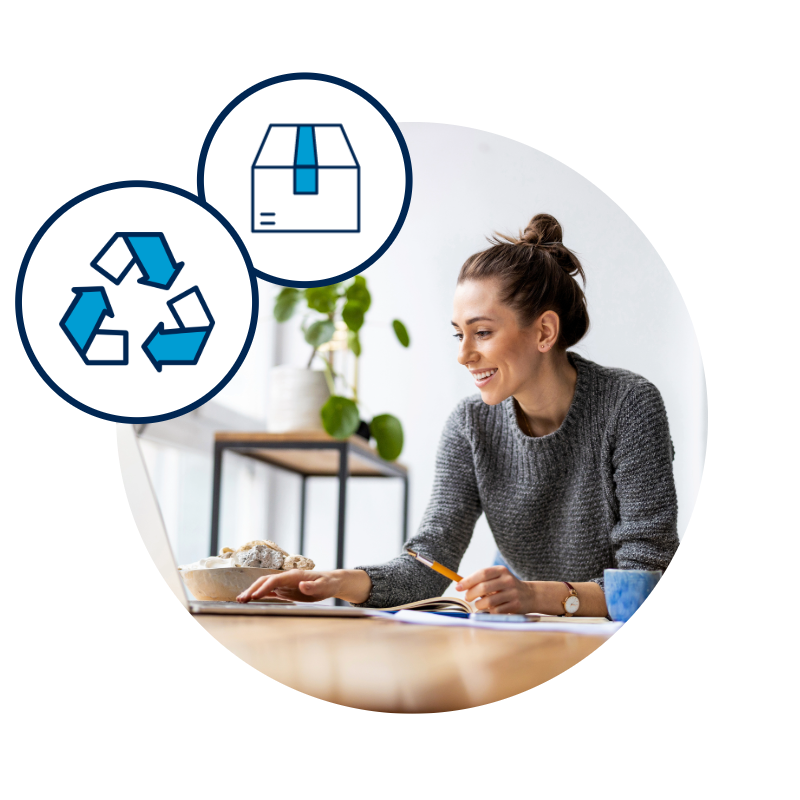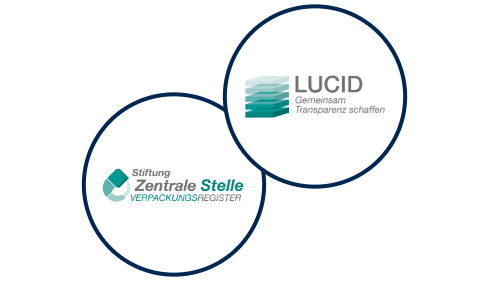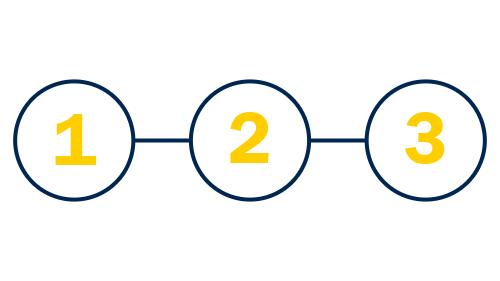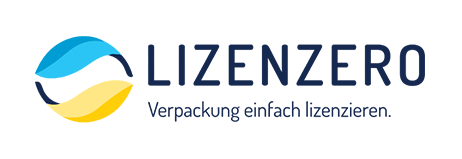What does a packaging licence cost?
Calculate easily with our calculation tool
Choose your packaging type:
-
Resources saved:
Resources saved
(Source: Fraunhofer UMSICHT)Here you can see how many kilograms of primary raw materials you save with your packaging licensing and its associated recycling. To clearly illustrate the volume saved, we also use a diagram containing the corresponding number of apples.
The calculated values are based on an annual study from the prestigious Fraunhofer Institute for Environmental, Safety and Energy Technology (UMSICHT).
We state the volume of primary raw materials saved and greenhouse gas emissions reduced by your company’s partnership with Interseroh on your personal resource protection certificate.
- 0 kg
- ≈ 0
Box S
Box S
Our reference box has the following specification:
Dimensions: 25,0 x 17,5 x 10,0 cm
Weight: Paper/paperboard/cardboard 65 g
Example: DHL Package S
Box S
incl. packing tape
Box S - incl. packing tape
Our reference box has the following specification:
Dimensions: 25,0 x 17,5 x 10,0 cm
Weight: Paper/paperboard/cardboard 65 g, plastic 2 g
Example: DHL Package S wrapped with PVC packing tape
Box S
incl. packing tape and paper filling material
Box S - incl. packing tape and paper filling material
Our reference box has the following specification:
Dimensions: 25,0 x 17,5 x 10,0 cm
Weight: paper/paperboard/cardboard 70 g, plastic 2 g
Example: DHL Package S wrapped with PVC packing tape + Kraft paper or wood wool
Box S
incl. packing tape and synthetic filling material
Box S - incl. packing tape and synthetic filling material
Our reference box has the following specification:
Dimensions: 25,0 x 17,5 x 10,0 cm
Weight: paper/paperboard/cardboard 65 g, plastic 12 g
Example: DHL Package S wrapped with PVC packing tape + bubble wrap with small bubbles
Air Cushion Envelope S
made of paper
Air bubble envelope S - made from paper
Our reference envelope has the following specification:
Dimensions: 180 x 265 mm
Weight: paper/paperboard/cardboard 15 g, plastic 2 g
Example: Padded paper envelope, DIN B5 format, lined inside with bubble wrap, size D4
Box M
Box M
Our reference box has the following specification:
Dimensions: 37,5 x 30,0 x 13,5 cm
Weight: paper/paperboard/cardboard 275g
Example: DHL Package M
Box M
incl. packing tape
Box M - incl. packing tape
Our reference box has the following specification:
Dimensions: 37,5 x 30,0 x 13,5 cm
Weight: paper/paperboard/cardboard 4 g
Example: DHL Package S wrapped with PVC packing tape
Box M
incl. packing tape and paper filling material
Box M - incl. packing tape and paper filling material
Our reference box has the following specification:
Dimensions: 37,5 x 30,0 x 13,5 cm
Weight: paper/paperboard/cardboard 300 g, plastic 4 g
Example: DHL Package M wrapped with PVC packing tape + kraft paper or wood wool
Box M
incl. packing tape and synthetic filling material
Box M - incl. packing tape and synthetic filling material
Our reference box has the following specification:
Dimensions: 37,5 x 30,0 x 13,5 cm
Weight: paper/paperboard/card 275 g, plastic 24 g
Example: DHL Package M wrapped with PVC packing tape+ bubble wrap with small bubbles
Air bubble envelope M
made of paper
Air bubble envelope M - made from paper
Our reference envelope has the following specification:
Dimensions: 220 x 340 mm
Weight: paper/paperboard/cardboard 22 g, plastic 3 g
Example: Padded paper envelope, DIN A4 format, lined inside with bubble wrap, size F6
Box L
Box L
Our reference box has the following specification:
Dimensions: 45,0 x 35,0 x 20,0 cm
Weight: paper/paperboard/cardboard 400 g
Example: DHL Package L
Box L
incl. packing tape
Container L - incl. packing tape
Our reference box has the following specification:
Dimensions: 45,0 x 35,0 x 20,0 cm
Weight: paper/paperboard/cardboard 400 g, plastic 6 g
Example: DHL Package L wrapped with PVC packing tape
Box L
incl. packing tape and paper filling material
Box L - incl. packing tape and paper filling material
Our reference box has the following specification:
Dimensions: 45,0 x 35,0 x 20,0 cm
Weight: paper/paperboard/cardboard 500 g, plastic 6 g
Example: DHL Package L wrapped with PVC packing tape + bubble wrap with small bubbles
Box L
incl. packing tape and synthetic filling material
Box L - incl. packing tape and synthetic filling material
Our reference box has the following specification:
Dimensions: 45,0 x 35,0 x 20,0 cm
Weight: paper/paperboard/cardboard 400 g, plastic 36 g
Example: DHL Package L wrapped with PVC packing tape + bubble wrap with small bubbles
Air Cushion Envelope L
made of paper
Air bubble envelope L - made from paper
Our reference envelope has the following specification:
Dimensions: 300 x 445 mm
Weight: paper/paperboard/cardboard 40 g, plastic 5 g
Example: Padded paper envelope, DIN A3 format, size I9
-
Resources saved:
Resources saved
(Source: Fraunhofer UMSICHT)Here you can see how many kilograms of primary raw materials you save with your packaging licensing and its associated recycling. To clearly illustrate the volume saved, we also use a diagram containing the corresponding number of apples.
The calculated values are based on an annual study from the prestigious Fraunhofer Institute for Environmental, Safety and Energy Technology (UMSICHT).
We state the volume of primary raw materials saved and greenhouse gas emissions reduced by your company’s partnership with Interseroh on your personal resource protection certificate.
- 0 kg
- ≈ 0
Shipping envelope S
without filling material
Shipping envelope S - without filling material
Our reference shipping envelope has the following specification:
Dimensions: 165 x 220 mm
Weight: plastic 10 g
Example: Plastic shipping bag for textile and courier shipping
Packaging cup S
Packaging cup S
Our reference packaging cup has the following specification:
Dimensions: Ø 15,5 cm x 6,8 cm (Capacity 500 ml)
Weight: plastic 19,4 g
Example: Salad bowls with hinged lid. Made of PET
Film S
Film S
Our reference film has the following specification:
Dimensions: 30 x 100 cm
Weight: Plastic 22 g
Example: Blown film or bubble wrap with large bubbles
Shipping envelope M
without filling material
Shipping envelope M - without filling material
Our reference shipping envelope has the following specification:
Dimensions: 245 x 320 mm
Weight: plastic 12 g
Example: Plastic shipping bag for textile and courier shipping
Packaging cup M
Packaging cup M
Our reference packaging cup has the following specification:
Dimensions: Ø 17,6 cm x 7,5 cm (Capacity 750 ml)
Weight: plastic 24,6 g
Example: Salad bowls with hinged lid. Made of PET
Film M
Film M
Our reference film has the following specification:
Dimensions: 60 x 200 cm
Weight: Plastic 45 g
Example: Blown film or bubble wrap with large bubbles
Shipping envelope L
without filling material
Shipping envelope L - without filling material
Our reference shipping envelope has the following specification:
Dimensions: 400 x 500 mm
Weight: plastic 15 g
Example: Plastic shipping bag for textile and courier shipping
Packaging cup L
Packaging cup L
Our reference packaging cup has the following specification:
Dimensions: Ø 18,9 cm x 8 cm (Capacity 1000 ml)
Weight: plastic 27,1 g
Example: Salad bowl with hinged lid. Made of PET
Film L
Film L
Our reference film has the following specification:
Dimensions: 120 x 200 cm
Weight: Plastic 90 g
Example: Blown film or bubble wrap with large bubbles
-
Resources saved:
Resources saved
(Source: Fraunhofer UMSICHT)Here you can see how many kilograms of primary raw materials you save with your packaging licensing and its associated recycling. To clearly illustrate the volume saved, we also use a diagram containing the corresponding number of apples.
The calculated values are based on an annual study from the prestigious Fraunhofer Institute for Environmental, Safety and Energy Technology (UMSICHT).
We state the volume of primary raw materials saved and greenhouse gas emissions reduced by your company’s partnership with Interseroh on your personal resource protection certificate.
- 0 kg
- ≈ 0
Bottle / jar S
with lid (plastic)
Bottle / jar S with lid – plastic
Our reference bottle/jar has the following specification:
Dimensions: Capacity 250 ml
Weight: glass 150 g, plastic 1 g
Example: Bottle with plastic lid
Bottle / jar S
with lid (aluminium)
Bottle / jar S with lid (aluminium)
Our reference bottle/jar has the following specification:
Dimensions: Capacity 250 ml
Weight: gass 150 g, aluminium 1 g
Example: Bottle with aluminium lid / cork stopper
Bottle / jar S
with lid (cork)
Bottle / jar S with lid (cork)
Our reference bottle/jar has the following specification:
Dimensions: Capacity 250 ml
Weight: glass 150 g, Other materials 1 g
Example: Bottle with cork stopper
Bottle / jar M
with lid (plastic)
Bottle / jar M with lid – plastic
Our reference bottle/jar has the following specification:
Dimensions: Capacity 750 ml
Weight: glass 500 g, plastic 1 g
Example: Bottle with plastic lid
Bottle / jar M
with lid (aluminium)
Bottle / jar M with lid (aluminium)
Our reference bottle/jar has the following specification:
Dimensions: Capacity 750 ml
Weight: glass 500 g, aluminium 1 g
Example: Bottle with aluminium lid
Bottle / jar M
with lid (cork)
Bottle / jar M with lid (cork)
Our reference bottle/jar has the following specification:
Dimensions: Capacity 750 ml
Weight: glass 500 g, other materials 1 g
Example: Bottle with cork stopper
Bottle / jar L
with lid (plastic)
Bottle / jar L with lid – plastic
Our reference bottle/jar has the following specification:
Dimensions: Capacity 1 l
Weight: glass750 g, plastic1 g
Example: Bottle with plastic lid
Bottle / jar L
with lid (aluminium)
Bottle / jar S with lid (aluminium)
Our reference bottle/jar has the following specification:
Dimensions: Capacity 1 l
Weight: glass 750 g, aluminium 1 g
Example: Bottle with aluminium lid
Bottle / jar L
with lid (cork)
Bottle/jar L with lid - Kork
Our reference bottle/jar has the following specification:
Dimensions: Capacity 1 l
Weight: Glass 750 g, Other materials 1 g
Example: Bottle with cork stopper
Paper, cardboard 0,000 kg
Plastics 0,000 kg
Glass 0,000 kg
Your license package:
Your annual licence contract includes the VerpackG-compliant licensing of the entered packaging quantities, the online seal as proof of your system participation, your annual Resources SAVED certificate and a service flat rate. To ensure that you are permanently legally compliant and do not have to worry about this every year, the contract is extended at the beginning of each year. You can cancel the contract yourself in your customer account up to 3 months before the end of each year.
25,00 € plus VAT
Once you have calculated your packaging weights, click on "CALCULATE YOUR LICENSE VOLUMES NOW" and you will be taken directly to our calculator, which will take the weight details and calculate the packaging licence costs for you at Lizenzero. You can then simply create an account here and proceed to payment and conclusion of the licence.
Your reporting obligations to a dual system (e.g. Interzero via Lizenzero) and also to the Central Agency Packaging Register (ZSVR) apply from the first packaging you put into circulation. You always license your volumes for a whole year. To do this, you report your planned packaging volumes and material types in kilograms. At the beginning of the next year, you check your details again and report the final value to your dual system and the ZSVR by 15 May at the latest as a year-end quantity report. This means that the volume you license for a year is initially only a forecast quantity without any claim to finality. You can adjust it as you wish over the course of the year and then have plenty of time to submit your final volumes in the new year until May.
In our calculation tool, you can select your packaging from various packaging materials and sizes. You can also filter whether packing tape and filling material should also be included.
Then simply enter the appropriate volumes for each type of packaging that you use over the course of a year into the calculator - and our calculation tool will convert everything into the corresponding weights in kilograms.

From 39 euros a year for your business –
priceless for the environment
According to the German Packaging Act, the companies that place packaging on the market are responsible for the recycling of sales packaging (all packaging intended for private end consumers). If you sell such packaging, you pay licence fees to a dual system depending on the amount of packaging and packaging material. This then takes over the collection, sorting and recycling of your packaging. This is how you fulfil your product responsibility.
At Lizenzero, in addition to our comprehensive services, personal advice and digital support, we offer one thing above all: the promise to work with you to conserve resources and protect the environment. As part of the Interzero dual system, we recycle your packaging, operate our own facilities and conduct ongoing research into recycling in order to get even more out of disposed packaging. This is how we protect valuable resources together. It's worth it.
With our calculation tool, you can easily calculate your volumes and licence them for as little as 39 euros per year.

What our customers say
Packaging weights calculated – what's next?

Take out a packaging licence with a dual system
You have calculated your packaging weights? Great, now it's time to take out a packaging licence, as this will fulfil your system participation obligation. According to the German Packaging Act, you are responsible from the very first packaging you sell to end consumers in Germany. This also applies if you sell your goods exclusively online, such as via digital Marketplaces.
With us, you can complete your licence in just three steps.
- Using your determined weights, you calculate your packaging licence costs in our calculator.
- Create a Lizenzero customer account and benefit from many great services that will make your life with the VerpackG easier.
- Select your payment method and confirm the conclusion of the contract.
That's it!
Registration with the ZSVR via the LUCID packaging register
In addition to your participation in a dual system, you also report your licensed volumes to the Central Agency Packaging Register (ZSVR). To do this, you register in the ZSVR's LUCID packaging register. You will then receive your LUCID registration number, which you enter at your dual system. This is how you link the two organisations together. Also important: regular data reporting to LUCID, which is also one of the to-do's from the VerpackG. Make sure that the volumes you report to the dual system and LUCID always match.
Your details will be published in the LUCID packaging register. This allows your competitors and potential customers to check whether you fulfil the VerpackG. In addition, the ZSVR compares your reported data with the information you have provided to your dual system. Incorrect information or unfulfilled obligations are considered an administrative offence and can lead to warnings, fines of up to 200,000 euros and sales bans.


Licensing: What we offer
Free additional services
Our goal: The best experience for you. For example, with our volume download for LUCID or our calculation tool. This is how we reduce hurdles – and make sustainable action as easy as possible.
All-round protected
With us, you can fulfil your obligations under the Packaging Act year after year with legal certainty.We will keep you reliably informed about important deadlines and changes.
Expertise for 30 years
We live the circular economy as an established dual system with real passion. With many other business areas, we are rethinking the circular economy and taking it further.
Vertrauen und Transparenz
Ihr Feedback nehmen wir uns zu Herzen und nehmen es als Ausgangspunkt für fortlaufende Optimierungen.
Questions and answers about your packaging licence costs
A packaging licence is required if you place packaging on the market in Germany - whether directly through the sale of products or through the import of packaged goods. The obligation to obtain a licence applies to all companies from the first packaging. Companies include manufacturers, retailers, online shops and importers. It is important to note that the responsibility lies with the first distributor of the packaging.
For all of them. There are no exceptions to the Packaging Act with regard to the material: as soon as the packaging is intended for end consumers, it is subject to licensing. Here are some examples:
- Paper, cardboard, carton (PPK) (shipping cartons, folding boxes, wrapping paper, etc.)
- Plastics (plastic bags, films, blister packs, jars, etc.)
- Glass (disposable bottles and jars)
- Aluminium (bottle caps, tubes for cosmetic products, etc.)
- Beverage carton packaging (consisting of cardboard and possibly a wafer-thin layer of aluminium and plastic)
- Other materials (wood, rubber, cotton, copper, ceramics, etc.)
- Other composite packaging (vacuum packaging for coffee, etc.)
- Ferrous metals (tin cans, beverage cans, crown caps, etc.)
You can obtain a low-cost packaging licence from us for as little as 39 euros per year. Our calculation tool will help you determine the exact amount.
The pre-licensing of packaging or the purchase of pre-licensed packaging is not permitted under the VerpackG. The only exception relates to so-called service packaging, which is used for the direct delivery of goods to end consumers (e.g. in the catering trade or in stationary retail). This sales packaging is the only pre-licensed packaging that may be purchased from packaging manufacturers/retailers.
This packaging is categorised as service packaging:
- Bakery bags
- Coffee-to-go cups
- Pizza boxes
- Carrier bags & pouches
Please note: The obligation to provide proof of the release of service packaging always lies with the final distributor, i.e. you, if you sell this packaging to end consumers. Therefore, you must have the licensing of the packaging confirmed by the supplier or manufacturer, or you can check the public register of the Central Agency Packaging Register to see if they are listed there.
If you put packaged goods into circulation for private end consumers, you must register your packaging with a dual system in accordance with Section 7 (1) VerpackG. If you fail to do so or declare incorrect volumes, this can be expensive - you could face fines of up to 200,000 euros and warnings from competitors. Thanks to the Central Agency's new transparency, it is clear which companies have licensed their packaging and which have not. This allows all market participants to keep an eye on each other - for fairer rules of the game in competition.
